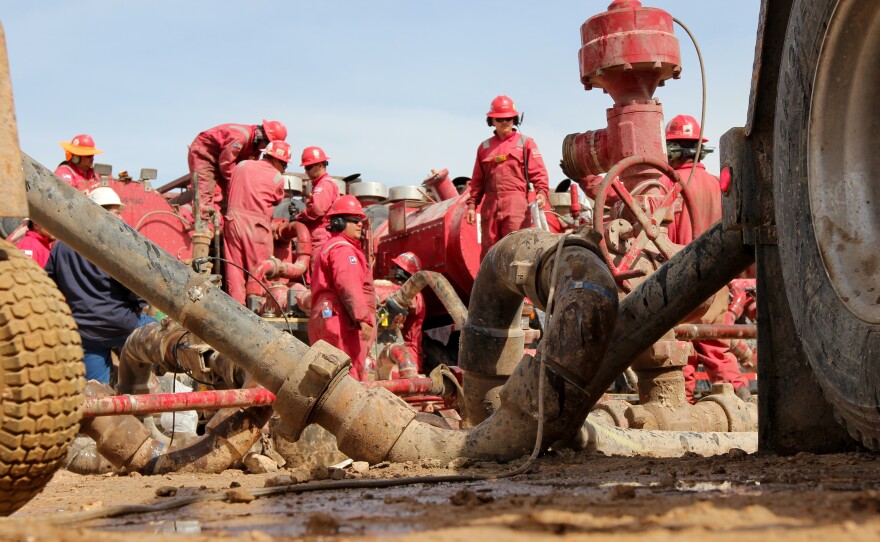The steep fall in the price of crude oil means hundreds of thousands of people are no longer working in the energy business and many small and mid-level energy companies are in a footrace against bankruptcy.
Yet, oil production is not dropping in places like the Permian Basin of west Texas and New Mexico, the nation's highest-producing oil field, where the din at a frack operation near Midland, Texas, signals the the soundtrack of a complex technology that's allowed the U.S. to reduce its dependence on foreign oil.
“This is the heart of the operation right here," said Sam Sledge, technical operations manager at Pro Petro, a drilling services company based in Midland. He showed me through a field that had been transformed into pipes, trucks, 2500 horse power pumps and dozens of scurrying workers.
During the oil boom, when the price of crude jumped to more than 100 dollars plus per barrel, there were approximately 30 fracking companies working that oil field. Today, it's fewer than 20.
Sledge said the market may be hurting that but the technology of what's called the "horizontal play" — drilling down, then sideways, extracting crude along that horizontal drill — is still working and constantly improving.
“It’s just been trial and error with this new horizontal play in west Texas over the last five to 10 years to just dial it in to where we’re going to get the most out of the rock as possible," Sledge said.
He showed me a trailer arrayed with computers and real-time charts monitoring the flow in the pumps connected to the well.
"Fourteen different pumps on location, shift gears, throttle up and down — all of that is where you can control the horse power from, right here," said Sledge.
As an industry, drillers are working to raise efficiency. One example is 3-D seismic readings, physics and software that pin down exactly where oil is, which means more fracks are successful. So despite low prices and a plummeting number of rigs working the Permian Basin, oil production is still rising. This time last year, there were 255 rigs here. Today, there's just 120. Yet production is higher, from 1.8 million barrels per day in April 2015 to two million in April 2016.
Fewer companies are doing the work. But those that remain can benefit because of those that have left.
"Right now, it's a pretty simple battle for market share," continued Sledge, who has an MBA from Baylor University.
"It's in our interest to survive because the companies that are going out of business are going to in turn give us their business when we turn back around."
Until then, survival means slashing costs, said Russell Gold, senior energy reporter at the Wall Street Journal and currently a fellow at the Energy Institute at the University of Texas, Austin. He's also the author of "The Boom: How Fracking Ignited the American Energy Revolution and Changed the World."
Gold laid out possible defensive strategies companies deploy in a downturn.
"The first thing you do is you get on the phone with everyone you do business with and you try to get a cut-rate," he said. “You make the case that, look, this is a major recession for the oil field and everyone's got to cut."
Gold said banks are also scrambling.
"There are a lot of regional banks right now that have a lot of oil field loans out there," he said. "They don't want to see everyone go belly up. So they're going to be in the business of selectively cutting some deals. You're going to go to your banker and say, 'Please, please give me more time. Let's renegotiate. Let's work this out.'"
I spoke with Dale Redman, Pro Petro's CEO, in his office in Midland. He is charismatic and exudes enthusiasm for the energy business even as it is buffeted by headwinds.
"It is going to work itself out. It is a cycle," Redman said. "And just about the time everybody says it's over, it comes back."
Redman takes the long view on a cyclical business.
"You have to look at this as a marathon, not a sprint," he said.
Redman said that downturns mean companies like his need to forge an even deeper partnership with oil and gas customers who have financial woes of their own.
“You have to be in tandem with what they’re trying to accomplish, and you better understand what their internal rates of returns are to get those costs down,” Redman said.
Many people wonder why producers don't cut production in the U.S. to restrict supply and thereby raise prices. Russell Gold explained many companies live under a mountain of debt and don't have the luxury of that option.
"They need to have cash coming in the door to pay off their loans," Gold said. "They can't just simply stop drilling. If you stop drilling, the cash stops coming in."
Critics have called the current energy predicament a "drilling treadmill," because even in the face of an oil glut and low prices, those who want to survive later must try to stay in the game now.





